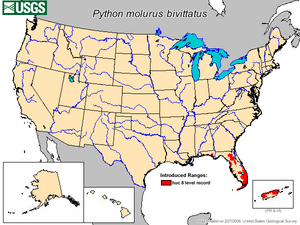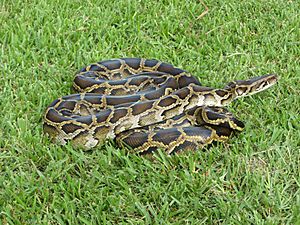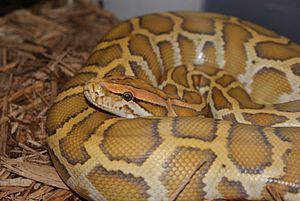Burmese python facts for kids
Quick facts for kids Burmese python |
|
|---|---|
 |
|
| Conservation status | |
| Scientific classification | |
| Genus: |
Python
|
| Species: |
bivittatus
|
 |
|
| Native distribution in green | |
| Synonyms | |
|
Python molurus bivittatus Kuhl, 1820 |
|
The Burmese python (Python bivittatus) is one of the biggest snakes in the world. It naturally lives in a large part of Southeast Asia. This snake is listed as a Vulnerable animal by the IUCN Red List, meaning its numbers are decreasing. Until 2009, scientists thought it was a type of Indian python, but now they know it's a separate species. In Florida, USA, it has become an invasive species because some snakes escaped from the pet trade.
Contents
What Does a Burmese Python Look Like?
The Burmese python is a dark-colored snake that is not venomous. It has many brown spots with black borders along its back. These snakes are very long and heavy. In the wild, they usually grow to about 5 meters (16 feet) long. Females are often a bit longer than males, but they are much heavier and bigger. For example, a female python that is 5 meters (16 feet) long can weigh around 75 kilograms (165 pounds)! Males are usually smaller. The longest Burmese python ever caught was 5.79 meters (19 feet) long in Florida in 2023.
Health Concerns for Pythons
Both in their natural homes and in places where they are invasive, Burmese pythons can get a parasitic disease. This disease is caused by a tiny worm-like creature called Raillietiella orientalis.
Where Do Burmese Pythons Live?
Burmese pythons are found across Southern and Southeast Asia. This includes countries like eastern India, Myanmar, Thailand, Laos, Cambodia, Vietnam, and parts of southern China. They also live on islands like Java and Bali in Indonesia.
These snakes are excellent swimmers and always need water nearby. They live in many different places, such as grasslands, swamps, rocky areas, and jungles near rivers. They are also good at climbing trees because they have a tail that can grip branches. They can stay underwater for up to 30 minutes, but they usually stay on land.
Burmese Pythons as an Invasive Species
Burmese pythons have spread widely in South Florida, especially in the Florida Everglades. Between 1996 and 2006, over 90,000 pythons were brought into the U.S. for the pet trade. In 1992, Hurricane Andrew destroyed a python breeding place and a zoo. Many snakes escaped and started living in the Everglades. Now, there are so many that they have become an invasive species.
These pythons are causing big problems for local wildlife. By 2007, they were found in other parts of Florida too. In 2012, the U.S. government banned importing Burmese pythons. A report from 2012 showed that in areas where pythons live, many native animals have almost disappeared. For example, raccoons were down by 99.3%, opossums by 98.9%, and white-tailed deer by 94.1%. They also eat birds and other reptiles. Very large pythons have even been seen attacking and eating American alligators and adult deer.
Efforts to Control Pythons
Many efforts have been made to reduce the number of Burmese pythons in Florida. One big event is the Florida Python Challenge. This is a contest where people try to catch as many pythons as possible. It offers prizes for the longest snake and the most snakes caught. The challenge helps people learn about the problem and encourages them to help remove pythons from the Everglades. In 2023, 1,050 people took part and removed 209 pythons.
Scientists are also finding new ways to track pythons. One method involves checking mosquito blood to see if mosquitoes have bitten pythons, which tells researchers where the snakes are.
Pythons in Florida have changed a bit. Unlike pythons in Asia, who often go long periods without food, Florida pythons eat all year because there's always food available. However, they don't like cold weather. Freezing winters can kill many of them.
Burmese Python Behavior
Burmese pythons are mostly active at night. When they are young, they can live both on the ground and in trees. But as they get bigger, they mostly stay on the ground. They are also amazing swimmers and can stay underwater for up to 30 minutes. Most of the time, they hide in thick bushes. In colder areas, they might go into a hollow tree or a hole in the ground to stay warm during winter. This is called brumation, which is like a deep sleep.
They usually live alone and are only found in pairs when they are mating.
Reproduction and Life Cycle
Burmese pythons breed in early spring. Females lay between 12 and 36 eggs in March or April. The mother snake stays with her eggs until they hatch. She wraps her body around them and twitches her muscles. This helps to keep the eggs warm. Once the baby snakes use a special "egg tooth" to cut their way out, the mother does not care for them anymore. The hatchlings often stay inside their eggs until they are ready to shed their skin for the first time. After that, they go hunting for their first meal.
Asexual Reproduction
Sometimes, Burmese pythons in zoos or other captive places can have babies without a male snake. This is called parthenogenesis, where the offspring are exact copies (clones) of their mother.
What Do Burmese Pythons Eat?
Like all snakes, Burmese pythons are meat-eaters. They mainly eat birds and mammals, but also amphibians and other reptiles. They are "sit-and-wait" predators. This means they stay still, waiting for an animal to come close. Then, they strike very quickly! The snake grabs its prey with sharp teeth, then wraps its body around the animal to squeeze it. This is called constriction. After the animal stops moving, the python swallows it whole.
Pythons are often found near people's homes because there are many rats, mice, and other small animals there for food. But they also like to eat farm birds and pets, so people sometimes see them as pests. In Florida, where they are invasive, they eat many small mammals like foxes, rabbits, and raccoons. Because they eat so much, they have caused many mammal species to disappear or decline. Very large pythons have even been known to eat alligators and adult deer!
How Pythons Digest Food
Burmese pythons are amazing at digesting huge meals. They often go a month or two between meals, and sometimes even longer. When they haven't eaten, their digestive organs shrink to save energy. But after they eat a big meal, their whole digestive system changes quickly. Their stomach gets bigger, they make a lot of stomach acid, and even their heart grows by 40% to help with digestion! Their body uses a lot of oxygen, up to 40 times more than usual, to power this process. This is because they have to rebuild their digestive system and make strong acid to break down their prey without chewing. The whole digestion process can take 8 to 14 days.
Protecting Burmese Pythons

The Burmese python is listed as a vulnerable animal by the IUCN Red List since 2012. This is because their wild population has dropped by at least 30% in the early 2000s. This decline is due to their habitat loss and too many being caught for the pet trade or for their skin.
To help protect them, experts suggest stronger laws and better enforcement to stop too many snakes from being caught. They also recommend more research to understand the python populations and what threatens them. In places like Hong Kong, Thailand, Vietnam, China, and Indonesia, the Burmese python is a protected species. However, they are still common only in Hong Kong and Thailand, and are rare in other parts of their natural home.
Burmese Pythons as Pets
Burmese pythons are often sold as pets because they have pretty colors and seem calm. But they grow very fast! They can reach over 2.1 meters (7 feet) in length in just one year if they are fed a lot. They reach their adult size by age four, but they keep growing slowly for their whole lives, which can be over 20 years.
Even though they can seem gentle, these are very strong animals. They can bite hard and even kill by squeezing. They also eat a lot of food and need very large, secure homes. Because of their size and needs, some owners release them into the wild. This is how they become invasive species and harm the environment. Because of this, some places, like Florida, have rules about keeping Burmese pythons as pets.
Pythons will almost always eat when food is offered, even if they just ate. This means pet pythons are often overfed, which can lead to health problems like obesity. If cared for properly, they can get used to living with humans.
Handling Large Pythons
Pythons are usually afraid of people because of our size and tend to avoid us. But because they are so strong when they are adults, it's important to be careful when handling them. It's often recommended that you have one person for every meter (3 feet) of snake to help handle it safely. Some places even require owners to have special licenses. It's always important to treat such a large animal with respect.
Different Types of Burmese Pythons
People who breed Burmese pythons often try to create snakes with different colors, patterns, and even sizes. One popular type is the "amelanistic" form, which is white with patterns in yellow and orange. There are also "labyrinth" pythons with maze-like patterns, khaki-colored "green" ones, and "granite" ones with many small spots.
Breeders have also been working with "dwarf" Burmese pythons from islands. These snakes are usually smaller, not growing much over 2.1 meters (7 feet) long, and have slightly different colors and patterns. One very rare and sought-after type is the "leucistic" Burmese python. These are completely bright white with blue eyes and no pattern at all. The "caramel" Burmese python has a caramel-colored pattern with dark brown eyes.
See also
 In Spanish: Pitón de Birmania para niños
In Spanish: Pitón de Birmania para niños
- Inclusion body disease, a viral disease that affects pythons







